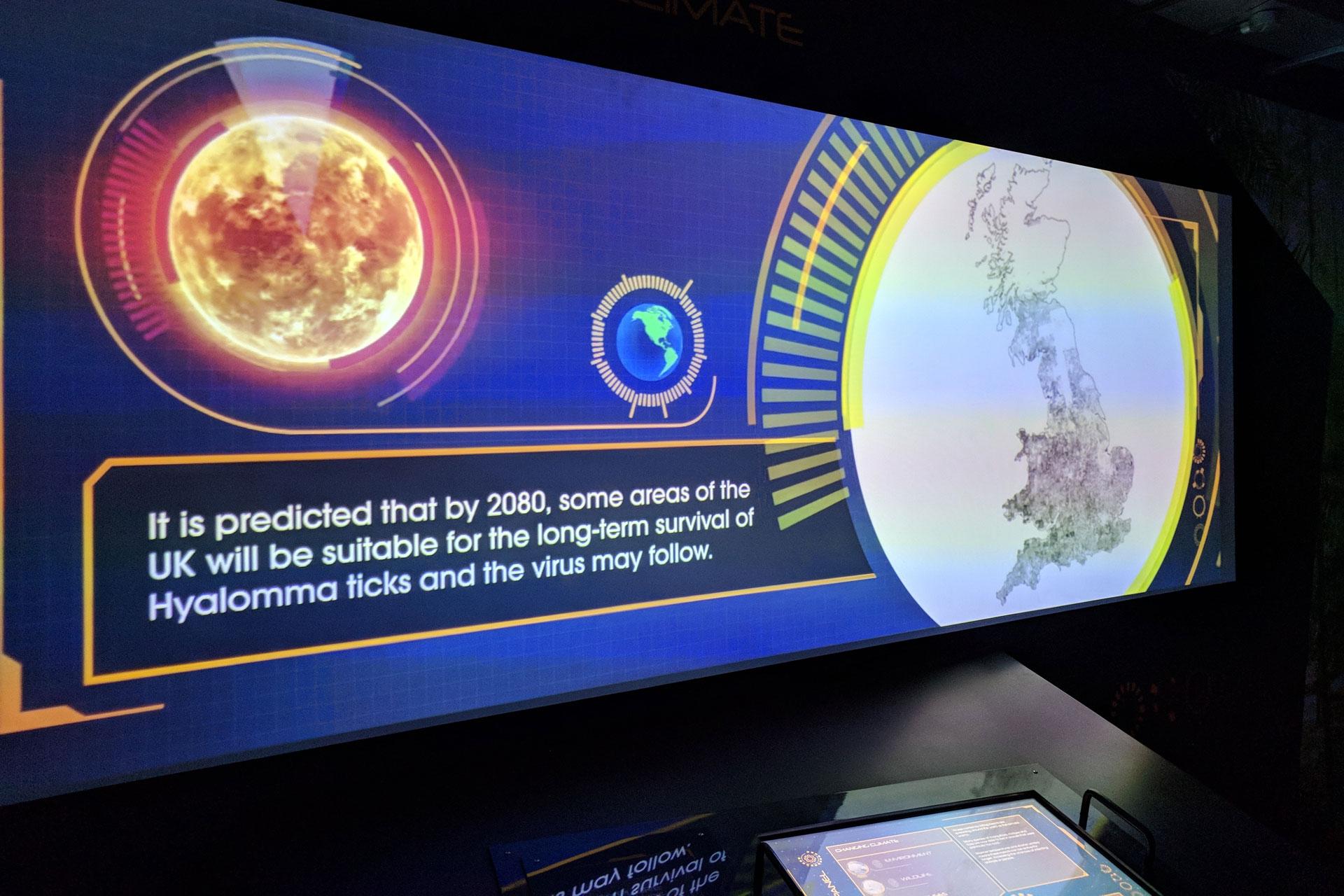The good health of animals is Marwell Zoo’s highest priority, but how can Marwell protect its residents against exotic diseases? Scientists at The Pirbright Institute have helped to create an exhibit in the Zoo’s new Tropical House to explain how climate change may increase the risk of diseases arriving in the UK that infect animals and people, and what can be done to prevent them from spreading.
Opened in March, the Tropical House is designed around the theme ‘Energy for Life’, where visitors are able to explore a tropical rainforest whilst using interactive exhibits to learn how our modern lifestyles are changing the global environment. Pirbright created high quality animated global maps which highlight the challenges climate change presents for the control of diseases such as bluetongue and Crimean-Congo haemorrhagic fever (CCHF).
The predicted increase in temperature across Europe and the UK is one of the driving forces that allows these diseases to spread further north from southern Europe and Africa. This enables the insects that spread these diseases (known as vectors) to survive at higher latitudes for longer periods of time, increasing the likelihood they are able to transmit disease between animals.
CCHF is a haemorrhagic disease that can cause high mortality rates in humans and is considered a priority emerging disease by the World Health Organization (WHO). It is spread by various species of Hyalomma tick, which prefer dry and hot areas of grassland, where they feed on animals and can infect them with CCHF. The animals do not present any clinical signs, so it is hard to detect if CCHF is circulating in local populations until a person is bitten by a tick and starts to display symptoms.
UK ticks are unable to transmit the disease to humans, but with the changing climate, the risk that Hyalomma ticks will establish populations further north is increasing. Migratory birds and horses can transport the tick into new areas and by 2080 the conditions may be warm enough for them to survive in the UK.
“The Hyalomma ticks are highly adapted to warm and dry conditions and as these conditions become more widespread across Europe as the climate changes, populations of these ticks are likely to become established, bringing with them the risk of CCHF to humans.” said Dr Marion England from the Entomology group at Pirbright.
Researchers at Pirbright are currently testing a vaccine which could protect sheep from the virus, and are conducting field studies to understand how the disease spreads amongst animals. Sheep form part of the natural reservoir for CCHF which can result in human disease, so vaccinating UK sheep is an important part of protecting human populations.
Bluetongue is another disease that infects sheep as well as goats, cattle and wild animals like buffaloes, deer, antelope and camels. Humans are not affected. The bluetongue virus is transmitted by Culicoides biting midges and until relatively recently, it was thought that northern European species of Culicoides were unable to transmit the virus.
Increases in temperature have meant that southern European and North African dwelling midges, that can transmit bluetongue virus, have expanded their range and are now overlapping with northern European populations. Unexpectedly, these northern populations have successfully transmitted the virus and there are now on-going outbreaks of bluetongue in northern Europe. The frequency and duration of these outbreaks are likely to increase as the climate changes.
There are several types of bluetongue virus and each one requires a different vaccine. Scientists at Pirbright work together with the Animal and Plant Health Agency (APHA) and the Met Office to understand where the different types of bluetongue virus are circulating and where infected midges are likely to travel based on weather patterns.
This helps to provide early awareness about incoming outbreaks so that susceptible animals can be vaccinated against the correct type of bluetongue virus. This year Marwell Zoo has protected its bluetongue susceptible animals through vaccination, including several rare species of antelope.
The exhibits at Marwell will give visitors an insight into the challenges scientists face when trying to understand how our actions are shaping the global environment. “I am glad that, with the help of the Marwell team, we are now able to inform the public about the many ways climate change can alter disease dynamics, ultimately affecting human and animal health,” said Dr England. “I studied how changes to the climate could impact the spread of CCHF for my doctoral thesis, so being able to bring this information to life in these interactive exhibits was extremely satisfying.”
Visit Energy for Life : Tropical House at Marwell this summer to discover more about infectious diseases and climate change.
